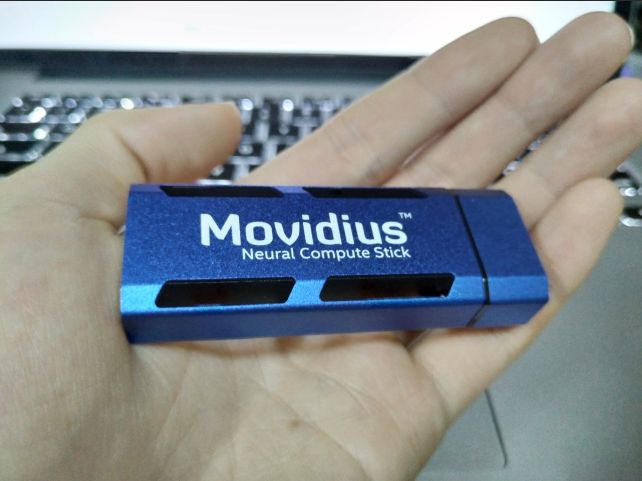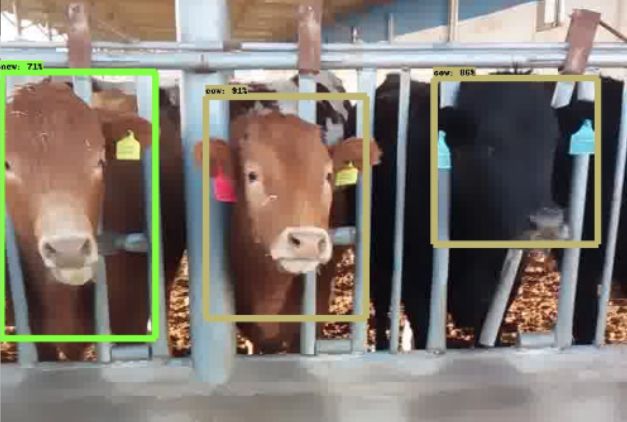树莓派3B+英特尔神经计算棒进行高速目标检测
转载请注明作者梦里茶
代码:
训练数据预处理:
https://gist.github.com/ahangchen/ae1b7562c1f93fdad1de58020e94fbdf
测试:https://github.com/ahangchen/ncs_detection
Star是一种美德。
Background
最近在做一个项目,要在树莓派上分析视频中的图片,检测目标,统计目标个数,这是一张样例图片:
Motivation
当下效果最好的目标检测都是基于神经网络来做的,包括faster rcnn, ssd, yolo2等等,要在树莓派这种资源紧张的设备上运行检测模型,首先想到的就是用最轻量的MobileNet SSD,使用Tensorflow object detection api实现的MobileNet SSD虽然已经非常轻,但在树莓派上推导一张1280x720的图仍然需要2秒,有兴趣的同学可以参考这两个项目:
- armv7版Tensorflow(必须是1.4及以上):https://github.com/lhelontra/tensorflow-on-arm/releases
- Tensorflow Object detection API: https://github.com/tensorflow/models/tree/master/research/object_detection
具体的操作在Tensorflow文档里都说的很清楚了,在树莓派上的操作也是一样的,有问题可以评论区讨论
Hardware
极限的模型仍然不能满足性能需求,就需要请出我们今天的主角了,Intel Movidius Neural Computing Stick
| 处理器 | Intel Movidius VPU |
|---|---|
| 支持框架 | TensorFlow, Caffe |
| 连接方式 | USB 3.0 Type-A |
| 尺寸 | USB stick (72.5mm X 27mm X 14mm) |
| 工作温度 | 0° - 40° C |
| x86_64 Ubuntu 16.04主机 | |
| Raspberry Pi 3B Stretch desktop | |
| Ubuntu 16.04 虚拟机 | |
| 系统要求 | USB 2.0 以上 (推荐 USB 3.0) |
| 1GB 内存 | |
| 4GB 存储 | |
实际上这不是一个GPU,而是一个专用计算芯片,但能起到类似GPU对神经网络运算的加速作用。
京东上搜名字可以买到,只要500元左右,想想一块GPU都要几千块钱,就会觉得很值了。
SDK是开源的:https://github.com/movidius/ncsdk
提问不在GitHub issue里,而是在一个专门的论坛:https://ncsforum.movidius.com/
虽然目前NCSDK支持的框架包含Tensorflow和Caffe,但并不是支持所有的模型,目前已支持的模型列表可以在这里查到:https://github.com/movidius/ncsdk/releases
截止到2018年3月15日,NCSDK还没有支持Tensorflow版的MobileNet SSD(比如tf.cast这个操作还未被支持),所以我们需要用Caffe来训练模型,部署到树莓派上。
Environment
ncsdk的环境分为两部分,训练端和测试端。
- 训练端通常是一个Ubuntu 带GPU主机,训练Caffe或TensorFlow模型,编译成NCS可以执行的graph;
- 测试端则面向ncs python mvnc api编程,可以运行在树莓派上raspbian stretch版本,也可以运行在训练端这种机器上。
训练端
安装
安装这个过程,说难不难,也就几行命令的事情,但也有很多坑
在训练端主机上,插入神经计算棒,然后:
git clone https://github.com/movidius/ncsdk
cd ncsdk
make install 其中,make install干的是这些事情:
- 检查安装Tensorflow
- 检查安装Caffe(SSD-caffe)
- 编译安装ncsdk(不包含inference模块,只包含mvNCCompile相关模块,用来将Caffe或Tensorflow模型转成NCS graph的)
注意,
- 这些库都是安装到
/opt/movidius/这个目录下,并关联到系统python3里边的(/usr/bin/python3),如果你电脑里原来有tf或caffe,也不会被关联上去 - NCSDK mvNCCompile模块目前只兼容python3,我尝试过将安装完的SDK改成兼容python2的版本,可以将模型编译出来,但是在运行时会报错,所以暂时放弃兼容python2了,也建议大家用默认的python3版本
这个步骤主要的坑来自万恶的Caffe,如果你装过python3版的caffe,大概会有经验一些,这里有几个小坑提示一下:
- 最好在ncsdk目录中的ncsdk.conf中,开启caffe的cuda支持,即设置
CAFFE_USE_CUDA=yes,这样你之后也能用这个caffe来训练模型 - caffe的依赖会在脚本中安装,但有些Debian兼容问题要解决
- 开启CUDA支持后,编译caffe会找不到libboost-python3,因为在Ubuntu16.04里,它叫libboost-python3.5,所以要软链接一下:
- 最好在ncsdk目录中的ncsdk.conf中,开启caffe的cuda支持,即设置
cd /usr/lib/x86_64-linux-gnu/
sudo ln -s libboost_python-py35.so libboost_python3.so- 其他可能出现的caffe的坑,可以在我博客找找答案,如果没有的话,就去caffe的GitHub issue搜吧
测试
一波操作之后,我们装好了ncsdk编译模块,可以下载我训练的caffe模型,尝试编译成ncs graph
git clone https://github.com/ahangchen/MobileNetSSD
mvNCCompile example/MobileNetSSD_deploy.prototxt -w MobileNetSSD_deploy.caffemodel -s 12 -is 300 300 -o ncs_mobilenet_ssd_graph这里其实是调用python3去执行/usr/local/bin/ncsdk/mvNCCompile.py这个文件, 不出意外在当前版本(1.12.00)你会遇到这个错误:
[Error 17] Toolkit Error: Internal Error: Could not build graph. Missing link: conv11_mbox_conf这是因为NCSDK在处理caffe模型的时候,会把conv11_mbox_conf_new节点叫做conv11_mbox_conf,所以build graph的时候就会找不着。因此需要为这种节点起一个别名,即,将conv11_mbox_conf_new起别名为conv11_mbox_conf,修改SDK代码中的/usr/local/bin/ncsdk/Models/NetworkStage.py,在第85行后面添加:
if ''_new' in name:
self.alias.append(name[:-4])于是就能编译生成graph了,你会看到一个名为ncs_mobilenet_ssd_graph的文件。
上边这个bug我已经跟NCSDK的工程师讲了,他们在跟进修这个bug:
测试端
NCSDK
测试端要安装ncsdk python api,用于inference,实际上测试端能做的操作,训练端也都能做
git clone https://github.com/movidius/ncsdk
cd api/src
make install从输出日志可以发现,将ncsdk的lib和include文件分别和系统的python2(/usr/bin/python2)和python3(/usr/bin/python3)做了关联。
然后你可以下一个GitHub工程来跑一些测试:
git clone https://github.com/movidius/ncappzoo
cd ncappzoo/apps/hello_ncs_py
python3 hello_ncs.py
python2 hello_ncs.py没报错就是装好了,测试端很简单。
OpenCV
看pyimagesearch这个教程
Caffe模型训练
就是正常的用caffe训练MobileNet-SSD,主要参考这个仓库:
- MobileNet-SSD: https://github.com/chuanqi305/MobileNet-SSD
README里将步骤讲得很清楚了
- 下载SSD-caffe(这个我们已经在NCSDK里装了)
- 下载chuanqi在VOC0712上预训练的模型
- 把MobileNet-SSD这个项目放到SSD-Caffe的examples目录下,这一步可以不做,但是要对应修改train.sh里的caffe目录位置
- 创建你自己的
labelmap.prototxt,放到MobileNet-SSD目录下,比如说,你是在coco预训练模型上训练的话,可以把coco的标签文件复制过来,将其中与你的目标类(比如我的目标类是Cattle)相近的类(比如Coco中是Cow)改成对应的名字,并用它的label作为你的目标类的label。(比如我用21这个类代表Cattle) - 用你自己的数据训练MobileNet-SSD,参考SSD-caffe的wiki,主要思路还是把你的数据转换成类似VOC或者COCO的格式,然后生成lmdb,坑也挺多的:
- 假设你的打的标签是这样一个文件
raw_label.txt,假装我们数据集只有两张图片:
data/strange_animal/1017.jpg 0.487500 0.320675 0.670000 0.433193
data/strange_animal/1018.jpg 0.215000 0.293952 0.617500 0.481013- 我们的目标是将标签中涉及的
图片和位置信息转成这样一个目录(在ssd-caffe/data/coco目录基础上生成的):
coco_cattle
├── all # 存放全部图片和xml标签文件
│ ├── 1017.jpg
│ ├── 1017.xml
│ ├── 1018.jpg
│ └── 1018.xml
├── Annotations # 存放全部标签xml
│ ├── 1017.xml
│ └── 1018.xml
├── create_data.sh # 将图片转为lmdb的脚本
├── create_list.py # 根据ImageSets里的数据集划分文件,生成jpg和xml的对应关系文件到coco_cattle目录下,但我发现这个对应关系文件用不上
├── images # 存放全部图片
│ ├── 1017.jpg
│ └── 1018.jpg
├── ImageSets # 划分训练集,验证集和测试集等,如果只想分训练和验证的话,可以把minival.txt,testdev.txt,test.txt内容改成一样的
│ ├── minival.txt
│ ├── testdev.txt
│ ├── test.txt
│ └── train.txt
├── labelmap_coco.prototxt # 如前所述的标签文件,改一下可以放到MobileNet-SSD目录下
├── labels.txt
├── lmdb # 手动创建这个目录
│ ├── coco_cattle_minival_lmdb # 自动创建的,由图片和标签转换来的LMDB文件
│ ├── coco_cattle_testdev_lmdb
│ ├── coco_cattle_test_lmdb
│ └── coco_cattle_train_lmdb
├── minival.log
├── README.md
├── testdev.log
├── test.log
└── train.log- 其中,标签xml的格式如下:
train
86
coco_cattle
720
1280
3
0
代表一张图中多个对象所在位置(bndbox节点表示),以及类别(name)。
- 一开始,
all,Annotations,images,ImageSets,lmdb四个目录都是空的,你可以把自己的图片放到随便哪个地方,只要在raw_label.txt里写好图片路径就行 读取
raw_label.txt,利用lxml构造一棵dom tree,然后写到Annotations对应的xml里,并将对应的图片移动到image目录里,可以参考这份代码。并根据我们设置的train or not标志符将当前这张图片分配到训练集或测试集中(也就是往ImageSet/train.txt中写对应的图片名)这样一波操作之后,我们的
images和Annotations目录里都会有数据了,接下来我们需要把它们一块复制到all目录下
cp images/* all/
cp Annotations/* all/- 然后用create_data.sh将
all中的数据,根据ImageSet中的数据集划分,创建训练集和测试集的lmdb,这里对coco的create_data.sh做了一点修改:
cur_dir=$(cd $( dirname ${BASH_SOURCE[0]} ) && pwd )
root_dir=$cur_dir/../..
cd $root_dir
redo=true
# 这里改成all目录
data_root_dir="$cur_dir/all"
# 这里改成自己的数据集名,也是我们这个目录的名字
dataset_name="coco_cattle"
# 指定标签文件
mapfile="$root_dir/data/$dataset_name/labelmap_coco.prototxt"
anno_type="detection"
label_type="xml"
db="lmdb"
min_dim=0
max_dim=0
width=0
height=0
extra_cmd="--encode-type=jpg --encoded"
if $redo
then
extra_cmd="$extra_cmd --redo"
fi
for subset in minival testdev train test
do
python3 $root_dir/scripts/create_annoset.py --anno-type=$anno_type --label-type=$label_type --label-map-file=$mapfile --min-dim=$min_dim --max-dim=$max_dim --resize-width=$width --resize-height=$height --check-label $extra_cmd $data_root_dir $root_dir/data/$dataset_name/ImageSets/$subset.txt $data_root_dir/../$db/$dataset_name"_"$subset"_"$db examples/$dataset_name 2>&1 | tee $root_dir/data/$dataset_name/$subset.log
done于是会lmdb目录下会为每个划分集合创建一个目录,存放数据
├── lmdb
│ ├── coco_cattle_minival_lmdb
│ │ ├── data.mdb
│ │ └── lock.mdb
│ ├── coco_cattle_testdev_lmdb
│ │ ├── data.mdb
│ │ └── lock.mdb
│ ├── coco_cattle_test_lmdb
│ │ ├── data.mdb
│ │ └── lock.mdb
│ └── coco_cattle_train_lmdb
│ ├── data.mdb
│ └── lock.mdb
- 将5生成的lmdb链接到MobileNet-SSD的目录下:
cd MobileNet-SSD
ln -s PATH_TO_YOUR_TRAIN_LMDB trainval_lmdb
ln -s PATH_TO_YOUR_TEST_LMDB test_lmdb- 运行
gen_model.sh生成三个prototxt(train, test, deploy)
# 默认clone下来的目录是没有example这个目录的,而gen_model.sh又会把文件生成到example目录
mkdir example
./gen_model.sh- 训练
./train.sh这里如果爆显存了,可以到example/MobileNetSSD_train.prototxt修改batch size,假如你batch size改到20,刚好可以吃满GTX1060的6G显存,但是跑到一定步数(设置在solver_test.prototxt里的test_interval变量),会执行另一个小batch的test(这个batch size定义在example/MobileNetSSD_test.prototxt里),这样就会再爆显存,所以如果你的train_batch_size + test_batch_size <= 20的话才可以保证你在6G显存上能顺利完成训练,我的设置是train_batch_size=16, test_batch_size=4
一开始的training loss可能比较大,30左右,等到loss下降到2.x一段时间就可以ctrl+c退出训练了,模型权重会自动保存在snapshot目录下
运行merge_bn.py将训练得到的模型去除bn层,得到可部署的Caffe模型,这样你就能得到一个名为
MobileNetSSD_deploy.caffemodel的权重文件,对应的prototxt为example/MobileNetSSD_deploy.prototxt离题那么久,终于来到主题,我们要把这个caffemodel编译成NCS可运行的graph,这个操作之前在搭环境的部分也提过:
mvNCCompile example/MobileNetSSD_deploy.prototxt -w MobileNetSSD_deploy.caffemodel -s 12 -is 300 300 -o ncs_mobilenet_ssd_graph参数格式:
mvNCCompile prototxt路径 -w 权重文件路径 -s 最大支持的NCS数目 -is 输入图片宽度 输入图片高度 -o 输出graph路径其实训练端相对于chuanqi的MobileNet-SSD没啥改动,甚至训练参数也不用怎么改动,主要工作还是在数据预处理上,可以参考我的预处理代码
树莓派NCS模型测试
现在我们要用ncs版的ssd模型在树莓派上进行对图片做检测,这个目标一旦达成我们自然也能对视频或摄像头数据进行检测了。
仓库结构
ncs_detection
├── data # 标签文件
│ └── mscoco_label_map.pbtxt
├── file_helper.py # 文件操作辅助函数
├── model # 训练好的模型放在这里
│ ├── ncs_mobilenet_ssd_graph
│ └── README.md
├── ncs_detection.py # 主入口
├── object_detection # 改了一下TF的Object detection包中的工具类来用
│ ├── __init__.py
│ ├── protos
│ │ ├── __init__.py
│ │ ├── string_int_label_map_pb2.py
│ │ └── string_int_label_map.proto
│ └── utils
│ ├── __init__.py
│ ├── label_map_util.py
│ └── visualization_utils.py
├── r10 # 图片数据
│ ├── 00000120.jpg
│ ├── 00000133.jpg
│ ├── 00000160.jpg
│ ├── 00000172.jpg
│ ├── 00000192.jpg
│ ├── 00000204.jpg
│ ├── 00000220.jpg
│ └── 00000236.jpg
├── README.md
└── total_cnt.txt- 由于这个工程一开始是用Tensorflow Object Detection API做的,所以改了其中的几个文件来读标签和画检测框,将其中跟tf相关的代码去掉。
- TF的图片IO是用pillow做的,在树莓派上速度奇慢,对一张1280x720的图使用Image的get_data这个函数获取数据需要7秒,所以我改成了OpenCV来做IO。
任务目标
检测r10目录中的图片中的对象,标记出来,存到r10_tmp目录里
流程
- 准备目标目录
def config_init(dataset_pref):
os.system('mkdir %s_tmp' % dataset_pref)
os.system('rm %s_tmp/*' % dataset_pref)- 指定模型路径,标签位置,类别总数,测试图片路径
PATH_TO_CKPT = 'model/ncs_mobilenet_ssd_graph'
PATH_TO_LABELS = os.path.join('data', 'mscoco_label_map.pbtxt')
NUM_CLASSES = 81
TEST_IMAGE_PATHS = [os.path.join(img_dir, '%08d.jpg' % i) for i in range(start_index, end_index)]- 发现并尝试打开神经计算棒
def ncs_prepare():
print("[INFO] finding NCS devices...")
devices = mvnc.EnumerateDevices()
if len(devices) == 0:
print("[INFO] No devices found. Please plug in a NCS")
quit()
print("[INFO] found {} devices. device0 will be used. "
"opening device0...".format(len(devices)))
device = mvnc.Device(devices[0])
device.OpenDevice()
return device- 将NCS模型加载到NCS中
def graph_prepare(PATH_TO_CKPT, device):
print("[INFO] loading the graph file into RPi memory...")
with open(PATH_TO_CKPT, mode="rb") as f:
graph_in_memory = f.read()
# load the graph into the NCS
print("[INFO] allocating the graph on the NCS...")
detection_graph = device.AllocateGraph(graph_in_memory)
return detection_graph- 准备好标签与类名对应关系
category_index = label_prepare(PATH_TO_LABELS, NUM_CLASSES)- 读取图片,由于Caffe训练图片采用的通道顺序是RGB,而OpenCV模型通道顺序是BGR,需要转换一下
image_np = cv2.imread(image_path)
image_np = cv2.cvtColor(image_np, cv2.COLOR_BGR2RGB)- 使用NCS模型为输入图片推断目标位置
def predict(image, graph):
image = preprocess_image(image)
graph.LoadTensor(image, None)
(output, _) = graph.GetResult()
num_valid_boxes = output[0]
predictions = []
for box_index in range(num_valid_boxes):
base_index = 7 + box_index * 7
if (not np.isfinite(output[base_index]) or
not np.isfinite(output[base_index + 1]) or
not np.isfinite(output[base_index + 2]) or
not np.isfinite(output[base_index + 3]) or
not np.isfinite(output[base_index + 4]) or
not np.isfinite(output[base_index + 5]) or
not np.isfinite(output[base_index + 6])):
continue
(h, w) = image.shape[:2]
x1 = max(0, output[base_index + 3])
y1 = max(0, output[base_index + 4])
x2 = min(w, output[base_index + 5])
y2 = min(h, output[base_index + 6])
pred_class = int(output[base_index + 1]) + 1
pred_conf = output[base_index + 2]
pred_boxpts = (y1, x1, y2, x2)
prediction = (pred_class, pred_conf, pred_boxpts)
predictions.append(prediction)
return predictions其中,首先将图片处理为Caffe输入格式,缩放到300x300,减均值,缩放到0-1范围,转浮点数
def preprocess_image(input_image):
PREPROCESS_DIMS = (300, 300)
preprocessed = cv2.resize(input_image, PREPROCESS_DIMS)
preprocessed = preprocessed - 127.5
preprocessed = preprocessed * 0.007843
preprocessed = preprocessed.astype(np.float16)
return preprocessedgraph推断得到目标位置,类别,分数
graph.LoadTensor(image, None)
(output, _) = graph.GetResult()其中的output格式为,
[
目标数量,
class,score,xmin, ymin, xmax, ymax,
class,score,xmin, ymin, xmax, ymax,
...
]- 根据我们感兴趣的类别和分数进行过滤
def predict_filter(predictions, score_thresh):
num = 0
boxes = list()
scores = list()
classes = list()
for (i, pred) in enumerate(predictions):
(cl, score, box) = pred
if cl == 21 or cl == 45 or cl == 19 or cl == 76 or cl == 546 or cl == 32:
if score > score_thresh:
boxes.append(box)
scores.append(score)
classes.append(cl)
num += 1
return num, boxes, classes, scores- 用OpenCV将当前图片的对象数量写到图片右上角,用pillow(tf库中的实现)将当前图片的对象位置和类别在图中标出
def add_str_on_img(image, total_cnt):
cv2.putText(image, '%d' % total_cnt, (image.shape[1] - 100, 50), cv2.FONT_HERSHEY_SIMPLEX, 1, (0, 255, 0), 2)result = vis_util.visualize_boxes_and_labels_on_image_array(
image_np,
np.squeeze(valid_boxes).reshape(num, 4),
np.squeeze(valid_classes).astype(np.int32).reshape(num, ),
np.squeeze(valid_scores).reshape(num, ),
category_index,
use_normalized_coordinates=True,
min_score_thresh=score_thresh,
line_thickness=8)- 保存图片
cv2.imwrite('%s_tmp/%s' % (dataset_pref, image_path.split('/')[-1]),
cv2.cvtColor(result, cv2.COLOR_RGB2BGR))- 释放神经计算棒
def ncs_clean(detection_graph, device):
detection_graph.DeallocateGraph()
device.CloseDevice()运行
python2 ncs_detection.py
结果
| 框架 | 图片数量/张 | 耗时 |
|---|---|---|
| TensorFlow | 1800 | 60min |
| NCS | 1800 | 10min |
| TensorFlow | 1 | 2sec |
| NCS | 1 | 0.3sec |
性能提升6倍!单张图300毫秒,可以说是毫秒级检测了。在论坛上有霓虹国的同行尝试后,甚至评价其为“超爆速”。
扩展
单根NCS一次只能运行一个模型,但是我们可以用多根NCS,多线程做检测,达到更高的速度,具体可以看Reference第二条。
Reference
- https://www.pyimagesearch.com/2018/02/19/real-time-object-detection-on-the-raspberry-pi-with-the-movidius-ncs/
- https://qiita.com/PINTO/items/b97b3334ed452cb555e2
看了这么久,还不快去给我的GitHub点star!

